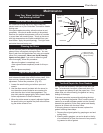
26
Dutchwest
7001219
Single Venting
Your stove requires a dedicated flue. Do not connect the
stove to a flue used by any other appliance. Chimney draft
is a natural form of energy and follows the path of least
resistance. If the stove is vented to a flue that also serves
an open fireplace or another appliance, the draft will also
pull air in through those avenues. The additional air flow will
lower flue temperatures, reduce draft strength and promote
creosote development; overall stove performance will suffer.
The effect is similar to that of a vacuum cleaner with a hole
in the hose. In some extreme instances, the other appliance
can even impose a negative draft and result in a dangerous
draft reversal.
Fuel
Even the best stove installation will not perform well with
poor fuel. If available, always use hardwood that has been
air-dried (“seasoned”) 12-18 months. Softwood burns more
rapidly than hardwood and has a high pitch content condu-
cive to creosote production. Decayed wood of any type has
little heat value and should not be used.
All unseasoned (‘green’) wood has a high moisture content.
Much of its heat value will be used to evaporate moisture
before the wood can burn. This significantly reduces not only
the amount of energy available to warm your home, but also
the intensity of the fire and temperature of the exhaust gas.
Incomplete combustion and cool flue temperatures promote
creosote formation and weak draft.
You can judge the moisture content of wood by its appear
-
ance and weight or use a commercially available moisture
meter for an exact measurement. Unseasoned wood will be
a third heavier than dry wood. Also, look for cracks (“check-
ing”) in the ends of the log that result from contraction as the
wood dries. The longer and wider the cracks are, the dryer
the wood is.
Purchase your fuel from a reputable dealer.
Creosote
Creosote is a by-product of low-temperature stove op-
eration, weak draft, or both. It is a tar that results when
unburned gases condense inside the flue system at tem-
peratures below 290˚ F. Creosote is volatile and can gen-
erate a chimney fire. All of the installation characteristics
that adversely affect chimney draft also promote creosote
condensation. Consequently, you can minimize creosote
accumulation with an effective chimney design and the use
of operational techniques that encourage good draft and
complete combustion.
Inspect your chimney frequently and clean it whenever accu
-
mulation is exceeds 1/4”.
Backpuffing
Backpuffing is a condition that results when the draft is too
weak to pull flue gases out of the chimney system as fast as
the fire generates them. Volatile gases build up within the
firebox until reaching a density and temperature at which
they ignite. With this ignition, you may hear a muffled pop
-
ping sound and see a bit of smoke forced out of the stove.
This condition is most likely to occur in the Spring or Fall
when moderate outdoor temperatures and low intensity fires
produce weak draft. If your stove back-puffs, open up the
damper to let the smoke rise to the flue more quickly. Also,
open the air inlets to induce a livelier fire and speed airflow
through the stove. Avoid large loads of firewood at one time.
You should always see lively, dancing flames in the firebox;
a lazy, smoky fire is inefficient and will promote draft prob
-
lems.
Draft Testing
An easy way to determine whether your chimney draft is
strong enough is to close the stove damper, wait a few
minutes to let the airflow stabilize, and then test whether
you can vary the strength of the fire by swinging the air
control open and closed. Results here are not instant; you
may need to wait a few minutes for a change in the air
control setting to have an effect on the fire. If there is no
change, the draft is not yet strong enough to let you close
the damper. You will need to open it for a while longer and
manage the fire with the air inlet until the draft strengthens.
Keep a record of your operating habits and relate them to
their effects on the stove’s function. You’ll be rewarded with
safe and efficient performance.
Negative Pressure
Good draft also depends on a sufficient supply of air to the
stove. The chimney can’t pull in more air than is available
to it. Sluggish draft can be caused by a house that is tight
enough to prevent the ready flow of air to the stove, or by
competition between the stove and other appliances that
vent indoor air to the outside; i.e., exhaust fans for range
hoods, clothes dryers, bathroom fans, etc. If the chimney
draws well when all such equipment is turned off (or sealed,
in the case of fireplaces and/or other stoves), you need
to be attentive in timing the use of the other appliances. If
you need to crack a nearby window or door to enable the
chimney to pull well, you should install an outside-air intake
to bring combustion air into the room.
Conclusion
Woodburning is more an art than a science. Art includes
technique; and since installations, homes, and fuel vary, the
stove operator must also vary technique, (mostly timing), to
achieve satisfying results. Over time, you will become famil-
iar with the features of your particular installation; you will
be able to identify cause and effect in a variety of seasonal
circumstances, and adapt your operating habits to changing
conditions.


















